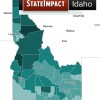Background
This page is no longer being updated. For ongoing coverage of this topic, go to Boise State Public Radio’s website.
Idaho’s unemployment insurance program is paid for by a tax on employers. Department of Labor Spokesman Bob Fick says the amount each business pays is based on its experience with the fund. In other words, if you’ve laid off a lot of people, you will pay a higher tax rate than a company that has never done layoffs. The department splits businesses into two categories; employers who’ve paid more in tax than their former employees collect in benefits and employers who’ve paid less in tax than their former employees have collected in benefits against them.
In Idaho, there are 14 different tax rates that businesses fall into. The basic rate an employer pays per worker is 3.36 percent on the first $33,300 of income. The highest rate is currently 6.8 percent on the first $33,300. Nearly all Idaho employers pay this tax. Exemptions include people who are self-employed (real estate agents, insurance agents, etc.) Officers of a corporation can also exclude themselves from coverage.
The unemployment insurance taxes are then pooled in a state trust fund, which pays benefits to laid-off workers. Fick says there is currently $155 million in Idaho’s fund. It has bounced back after being broke during the recession. Idaho borrowed more than $202 million from the federal government beginning in June 2009 to pay the flood of unemployment benefit claims. The state has repaid those loans, in full, by selling revenue bonds. Idaho also received federal stimulus (American Reinvestment and Recovery Act) funding to help pay claims during the height of the recession.
“Under the stimulus bill, the state received $32.2 million in exchange for liberalizing benefits, allowing benefits for part-time workers who were laid off and still only wanted to work part-time, for unemployed people in approved training programs and use of the last or fifth quarter of wages in calculating eligibility if the first four of the last five quarters do not qualify the applicant. The 32.2 million came in and went out immediately as benefits.” – Bob Fick, Idaho Department of Labor
Who qualifies for state unemployment insurance benefits?
Laid-off workers in Idaho can collect up to 26 weeks of state unemployment insurance benefits. Here are some of the requirements needed in order to qualify for receiving benefit payments:
- You must be totally or partially unemployed through no fault of your own (if you’re fired or quit, you can’t qualify for benefits).
- Be a U.S. citizen or legally authorized to work in the U.S.
- Establish monetary entitlement to benefits by having sufficient earnings in the base period: You must have worked and been paid wages for employment in at least two of the quarters in your base period. You must have been paid at least $1,872 in wages in one of those quarters. The total wages paid in your base period must equal one and a quarter times your highest quarter wages.
- You must be available for full-time work.
- You must be able to perform full-time work.
- You must be willing to actively seek full-time work.
Benefit payments to unemployed Idahoans vary based on salary and years in the workforce. The Department of Labor uses two calculations to determine the benefit amount and the duration of the benefit. It’s different for every person. The minimum benefit is $72 per week for ten weeks. The maximum benefit is $336 per week for 26 weeks.
How do federal extended unemployment and emergency unemployment benefits work?
The federal government offers an additional safety net for workers who have been laid off. Extended unemployment benefit programs are in addition to individual state programs. The federal government has offered various extensions when the unemployment rate reaches a certain level. Those extensions vary.
There are two types of federal extensions available to laid-off Idahoans: emergency unemployment compensation and federal-state extended benefits. Idaho Department of Labor spokesman Bob Fick says those federal payments are based on the initial state benefit:
“The first type is emergency unemployment compensation, it is divided into four parts and you move through each part, increasingly trying to find a job as you move along. The first tier is 80 percent of your state basic benefit, the second tier is 54 percent the third tier is 50 percent and the final tier is 24 percent. If you move through all those tiers every week, making at least two job contacts and still unable to find work, you move into a program called federal-state extended benefits.” — Fick
If someone qualifies for the maximum Idaho benefit, which is 26 weeks, here is what the total maximum unemployment insurance benefits would look like:
[spreadsheet key=”0AiLU6Cs5LWZIdDJWV0xEQmc2RVJscWd1Y3VqYi1OQUE” source=”Idaho Department of Labor” sheet=0 filter=0 paginate=0 sortable=1]
Who pays for federal unemployment benefits?
Like the state system, the federal unemployment benefit system is also paid for through a tax on employers. The federal unemployment tax is currently six percent on the first $7,000 of an employee’s wage. But, in Idaho, employers pay just eight-tenths of a percent on the first $7,000. That’s $56 per worker. “Employers who belong to a state system that meets federal requirements, as Idaho’s does, they get a credit for 5.2 percent of the tax,” says Labor spokesman Bob Fick.
That tax revenue then gets funneled into three different federal trusts. One provides grants that operate state labor departments, the second provides loans to states whose own trust funds go broke (like Idaho’s did), and the third finances extended unemployment benefits. “Those trust funds in 2008 had multiple billions of dollars,” says Fick. “Clearly, the recession went on longer than those trust funds could bear, and for the last two years the federal treasury has financed extended benefits.”
Idaho’s Department of Labor reports unemployed workers in the state have collected $750 million in federal extended benefits since 2008.











